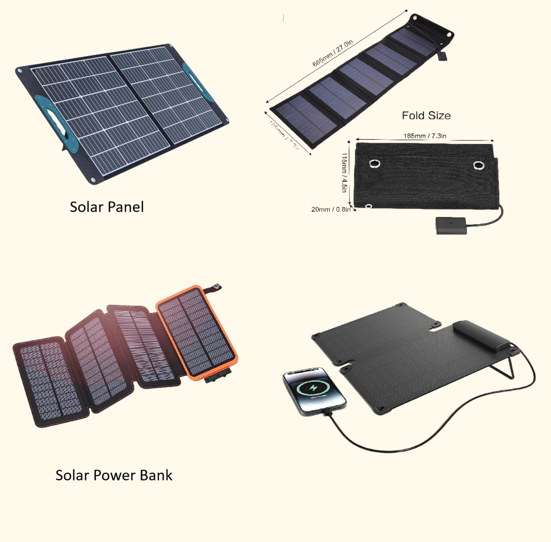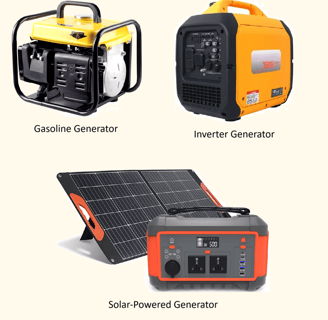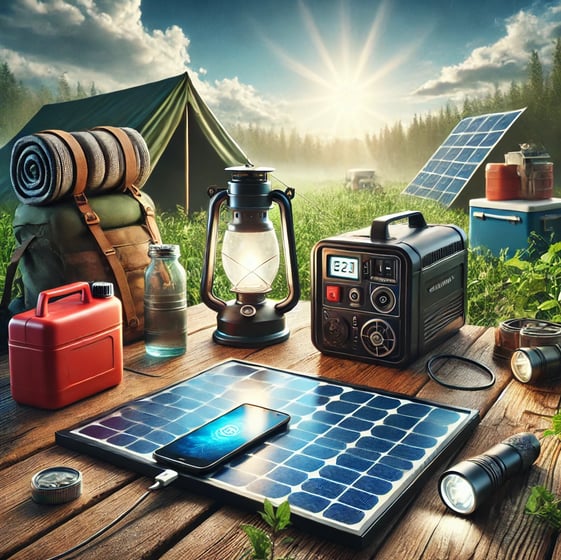Alternative Energy
Use solar chargers or small generators for electricity needs.
12/5/20243 min read
Alternative Energy
Use solar chargers or small generators for electricity needs. Access to electricity during emergencies or in off-grid situations is crucial for powering essential devices like lights, communication tools, and small appliances.
Solar chargers and small generators offer reliable, renewable, and portable solutions. Here's a detailed guide on how to use them effectively.


1. Solar Chargers
Solar chargers convert sunlight into electricity, making them an eco-friendly and renewable power source.
A. Types of Solar Chargers
Portable Solar Panels:
Lightweight and foldable, ideal for charging small devices like phones, flashlights, or portable batteries.
Solar Power Banks:
Combine a solar panel with a built-in battery to store energy for use at night or during cloudy weather.
Solar Generators:
Larger systems are designed to power appliances and tools.
B. How Solar Chargers Work
Step 1: Position the solar panel in direct sunlight for maximum efficiency.
Step 2: Connect your device using a USB or DC cable.
Step 3: Monitor charging and adjust the panel's position as the sun moves.
C. Choosing the Right Solar Charger
Device Compatibility: Ensure it can charge your devices (e.g., USB for phones, DC ports for laptops).
Wattage: Higher wattage panels (20-100W) charge devices faster and support larger batteries.
Portability: Opt for compact models if you need mobility.
D. Advantages of Solar Chargers
Sustainable: Free energy from the sun.
Silent Operation: Unlike generators, they produce no noise.
Low Maintenance: Requires occasional cleaning of the panels.
E. Limitations
Dependent on sunlight availability.
Slower charging compared to generators.
2. Small Generators
Small generators provide backup electricity by converting fuel into power. They are ideal for running larger appliances or during prolonged power outages.
A. Types of Small Generators
Gasoline or Diesel Generators:
Efficient and widely available, but require fuel storage.
Inverter Generators:
Quieter and produce cleaner electricity, suitable for sensitive electronics.
Solar-Powered Generators:
Combine solar panels with a battery for a renewable energy solution.
B. How Small Generators Work
Step 1: Add fuel (for gas generators) or ensure battery charge (for solar generators).
Step 2: Connect your devices or appliances via electrical outlets on the generator.
Step 3: Start the generator and monitor fuel or power levels.
C. Choosing the Right Generator
Power Output: Determine your power needs (e.g., a 2,000-watt generator can run lights, a fridge, and small electronics).
Fuel Type: Gasoline is common, but consider solar or dual-fuel options for versatility.
Portability: Choose a lightweight model with wheels for easy transport.
D. Advantages of Small Generators
Reliable Power: Works in all weather conditions.
Higher Capacity: Powers larger appliances and tools.
Quick Charging: Charges batteries and devices faster than solar chargers.
E. Limitations
Fuel storage and availability can be challenging during crises.
Produces noise and emissions (except solar generators).
3. Key Use Cases for Solar Chargers and Small Generators
A. Emergency Preparedness
Solar Chargers: Keep essential devices (phones, radios, flashlights) charged during blackouts.
Small Generators: Provide power for medical equipment, refrigerators, or heating systems.
B. Off-Grid Living
Use solar chargers for sustainable, everyday power needs.
Rely on generators as backup during prolonged cloudy days or heavy energy usage.
C. Outdoor Activities
Solar chargers are perfect for camping, hiking, or travelling where electricity isn’t accessible.
Small generators can support RVs or larger group setups.
4. Maintenance Tips
For Solar Chargers
Clean the panels regularly to remove dust or debris that may block sunlight.
Avoid placing heavy objects on flexible panels to prevent damage.
For Small Generators
Store fuel properly to prevent degradation.
Change the oil and air filters regularly for gasoline/diesel generators.
Test-run generators periodically to ensure functionality.
5. Combining Solar and Generators
For maximum reliability, combine solar chargers with small generators:
Use solar chargers during the day to save fuel and reduce costs.
Rely on generators at night or during emergencies when solar power isn’t available.
By incorporating solar chargers and small generators into your survival plan, you ensure a steady and versatile electricity supply for critical needs.




